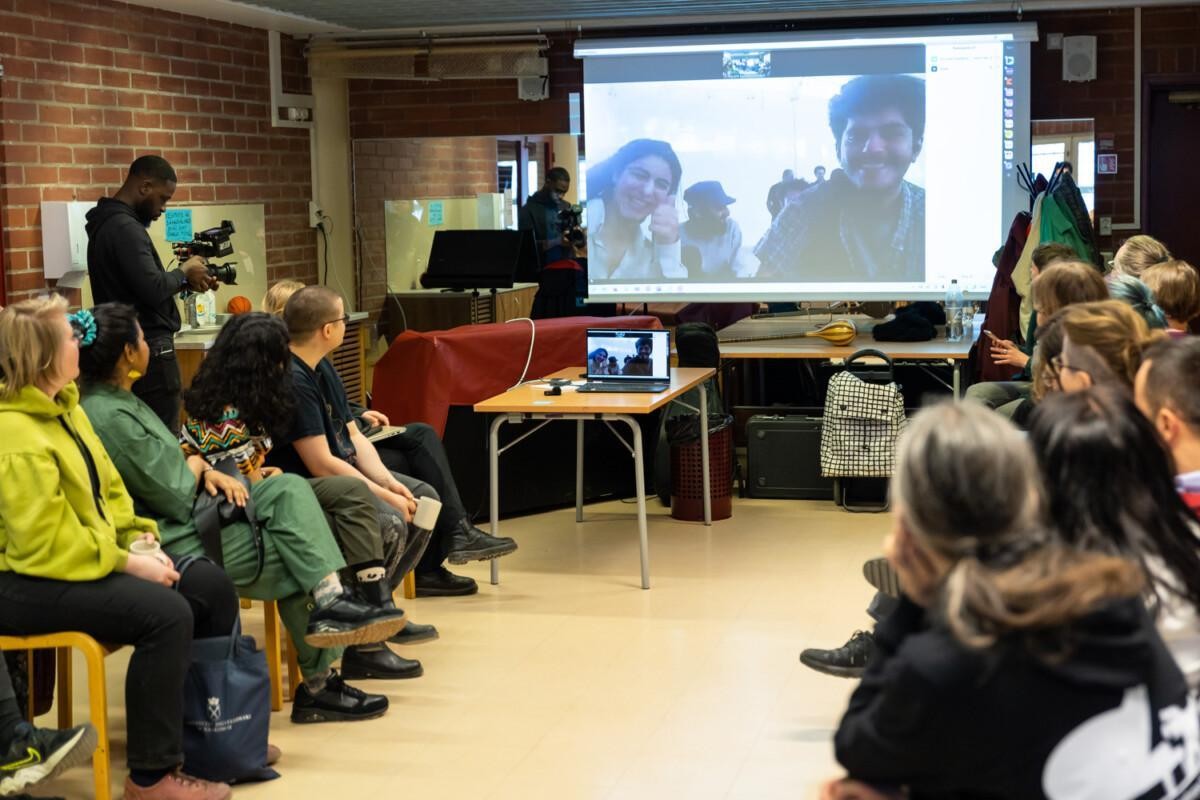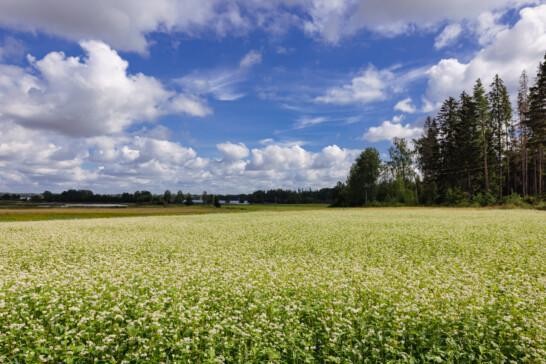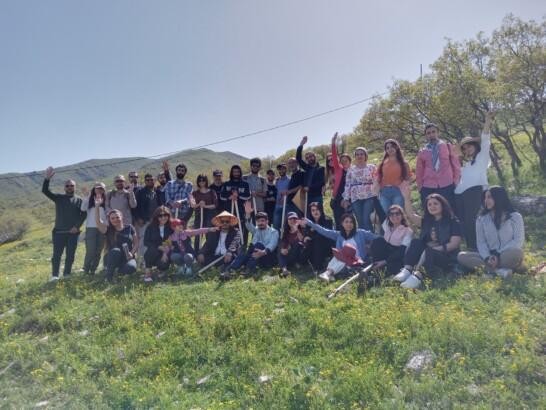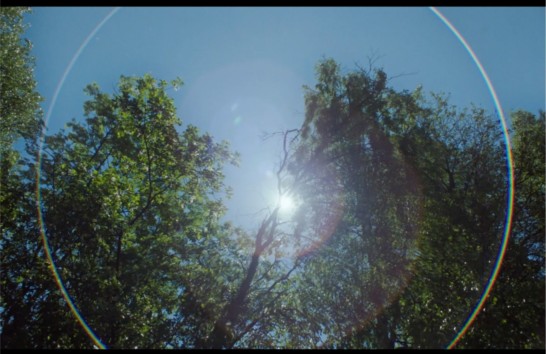Curator’s texts
Let’s make the future now

This is the second in a series of articles by Paula Toppila, Executive Director and Curator of IHME Helsinki. In 2018, IHME Helsinki began the organisation’s ecological transition from IHME Contemporary Art Festival (2009–2018) to being a contemporary-art-commissioning organisation that combines art, science and climate work. These texts reflect on the role of art and art institutions in the sustainability transition. When the first blog was published, it was called Imagine the Future Now, but we have changed that to Let’s Make the Future Now, because the environmental crisis is not waiting, it is advancing, and more action is needed all the time.
International cooperation in a world of environmental crisis
In my first blog, I wrote about the role of art and art institutions in our crisis-filled times from the perspective of the German sociologist Hartmut Rosa’s concept of resonance. I looked at the changing values in institutional practices and how in an ecologically sustainable culture success can be measured in more than just quantitative (economic) terms. I also looked at the potential of culture and the arts to increase resilience to crises, where the strengths of both are linked to increasing equality: the ability to bring people together, to increase their understanding of the world, to create opportunities to be heard, and to feel a sense of belonging.
Here, I will consider what international cooperation means in an ecologically sustainable arts institution. Air travel is an integral part of this. In my own career since the 1990s dialogue across national borders has become increasingly commonplace, with globalisation, free movement, international-education opportunities, residency programmes and digitalisation.
For a long time, air travel was cheap and little thought was given to its role as a source of carbon emissions. This made it possible for large numbers of professionals and art tourists to travel by air, even impulsively. How should international cooperation between artists and art institutions be implemented in a world of environmental crisis so as to stay within the limits of the planet, and to promote the values and cultural change needed in that crisis?
Before I go into this in the context of IHME Helsinki, we should remember that the culture and arts sector is by no means the biggest emitter, compared to, say, the high-emissions defence sector. On the contrary, arts and culture are of great importance as a force for change, and consequently we should be involved in creating operating methods that fit within the planet’s limits.
At its best, international cooperation is also a means of promoting solidarity, cultural diversity, and equality. In these times of conflict, it is also important to see the role of art and culture as part of diplomacy, as evidence that we are listening and seeing what is happening in the world, that we are contributing to peace, human rights and democracy.
What to reimagine, how, why, and who for?
When considering an organisation’s or cultural institution’s international cooperation in a world of environmental crisis, the key questions are: what, how, why, and for whom. What does our organisation do in the international context? How are we doing it? Why do we do it? And who are we doing it for? The answer to the why question can be found in the basic mission of our organisation, in the foundation context we talk about the foundation’s purpose, why we exist.
The next question could be, what does our work look like in this world of environmental crisis? Should it be revised? The purpose of the foundation that runs IHME Helsinki is to support new and critical art, and international dialogue, and to broaden the audience base for which we produce art. International collaboration is thus built into our ethos. That is why we work with artists from abroad, and also work abroad.
Climate work has also been one of our priorities since 2018. We challenged ourselves to combine the aims of the Foundation with living within life-sustaining systems. We have calculated our carbon footprint over the past five years and learned that we can carry out our core activities with low emissions. Our annual emissions are equivalent to the annual emissions of about two Finns. Our biggest emissions are from air travel: by artists, experts, and myself as Executive Director and Curator. Nevertheless, we also try to minimise these emissions by keeping the number of flights to a minimum.
Like everyone else after the Corona period, we use remote connections for meetings and, when we travel, we try to combine multiple destinations and travel over land where possible. This means that, with sustainability in mind, careful planning and foresight have become more important in our operations. We also have a long-term plan for reducing emissions and a set carbon budget to guide our planning of operations. We have also addressed life-sustaining systems in a variety of ways in our annual artworks.
The next question is, for whom do we do what we do? When considering how much natural resources an art institution uses, it matters where our audiences are and how those audiences arrive where the art is. Since the time of the IHME contemporary art festival productions, IHME Helsinki has been devising its programmes for diverse audiences, mostly in the Helsinki metropolitan area, but also in other parts of Finland.
We have not attempted to make IHME commissions for international art tourists, nor does our approach of making only one temporary work per year support this. People have to be exceptionally motivated to travel abroad for a single artwork, and that’s fine, they shouldn’t – unless they travel overland or choose an art destination for a holiday journey by air that they take, say, once every three to five years.
From local to multi-local
Besides air travel, art institutions also generate emissions from the transportation of artworks resulting from international cooperation. At IHME, we produce new, temporary, situation and context-specific works that are produced locally, i.e. we do not transport works or parts of works over long distances.
Thanks to our artists, who are inspired by the challenges of ecological sustainability, the IHME Helsinki commissions that we produce can, in any case, gain audiences abroad, with low emissions. For example, IHME Helsinki has produced an artwork – Katie Paterson’s To Burn Forest Fire – so small that it fits into an envelope and can be posted to be part of exhibitions in several countries. Listening Through the Dead Zones, a sound work conceived by artist Jana Winderen, was scaled down from a spectacular outdoor installation in Helsinki to be listened to in exhibitions on headphones, so that only the audio file travels across the Internet.
Artist Amar Kanwar created a work in the form of an online course that can be run anywhere without the artist or participants travelling. At the same time, we carried on Kanwar’s long-standing project with the local rural community in his home country of India. Most recently, we produced a participatory artwork with Kurdish artist Hiwa K, simultaneously in Finland and in Iraqi Kurdistan, in both locations for local audiences. The content focussed on the impact of neoliberalism on everyday environments, bringing both climate change and nature loss into the discussion.
International cooperation can easily add to an art institution’s emissions, but as the above examples show, these, too, can be modified. Over the last five years, many arts and cultural events and institutions in Finland have seriously considered the limits of the planet and adopted more sustainable institutional practices: renewable forms of energy, recycling of materials, longer exhibition durations, sharing ecologically sustainable operating models, etc. Reducing emissions-generating activities has proved possible without basic operations suffering in any way.
At the same time, they are considering how to develop activities with an awareness of emissions, but also content and services: what opportunities will arise from longer exhibition periods, for example, in terms of audience outreach or events? The most important thing, however, is to consider what is achieved with the emissions, from the perspective of both the organisation’s mission and the sustainability transformation.
Joining forces and continuing to learn together
Over the last couple of years, we Finnish visual-arts organisations and associations have come together to form the Sustainable Visual Arts Network. Its purpose is to act as a peer network and to support member organisations’ sustainable transition. The Network’s programme of events, which is open to all, includes an annual Sustainable Visual Arts Day, which was held for the first time in April this year, produced by Frame. As part of the event, a Green Art (vihreataide.fi) website and a carbon footprint calculator for art professionals were launched. Around 100 people attended the event on site at Helsinki’s University of the Arts and over 250 people followed the live stream.
The event reached around 100 visual-arts organisations. International peer community abroad is also important for this network, both for joint learning, sharing, and inspiration. The more widespread ecologically sustainable practices become, the better for the future of international cooperation and for the planet.
Paula Toppila
Managing Director, Curator IHME Helsinki
Chair of the Sustainable Visual Arts Network in 2024
Translated with DeepL.com (free version), revised by M.


